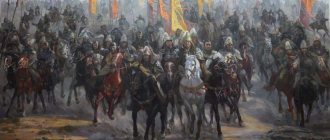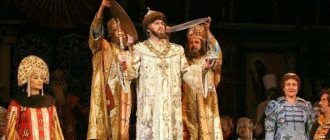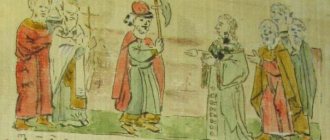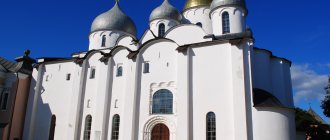Life of the Righteous Prince Yuri Vsevolodovich
Prince George was born in 1119 in the city of Vladimir Klyazmensky. He was one of the sons of Grand Duke Vsevolod Yuryevich Big Nest, who was the brother of Saint Prince Andrei Bogolyubsky, and Grand Duchess Maria Shvarnovna. Historical chronicles say that when the little prince was 3 years old, a prayer service was served, his hair was cut and he was put on a horse, which meant that from that moment on, men were involved in his upbringing.
When the prince turned 19 years old, his mother fell ill and, having taken monastic vows in the Dormition Princess Monastery she founded, went to the Lord. On April 14, 1212, his father also died, bequeathing the grand-ducal throne to George before his death, even though he was not his eldest son. The elder brother Konstantin did not accept this at all. But soon enmity broke out between them for another reason: their younger brother Yaroslav was removed from the Novgorod reign. George supported his younger brother, while Konstantin sided with the Novgorodians. Konstantin emerged victorious from this confrontation, but was favorable to George and Yaroslav - he gave one Suzdal, the other Pereyaslavl. Before his death in 1218, Constantine entrusted his children to his younger brother George, who took care of them all his life, like his own father. George was distinguished by his ability to pacify other princes who were dissatisfied with something. His military successes in campaigns against Volga Bulgaria and Mordva are known. The prince also became the founder of Nizhny Novgorod, which he founded in 1221.
Grand Duke Georgy Vsevolodovich travels on boats around the newly conquered lands at the mouth of the Oka River. Artist G. Maltsev
In 1237, the Tatar-Mongol hordes of Batu moved to Rus'. During the wars, the Tatars ravaged Ryazan and Moscow and captured his son Vladimir. Prince George left Vladimir, leaving his sons Mstislav and Vsevolod at the head of the defense of the city, and stood on the City River with his nephews - the sons of his late brother Konstantin, expecting military help from his brothers Yaroslav, Svyatoslav and John. However, at this time he received terrible news: the city of Vladimir fell, the Tatars killed the entire family of the prince - his wife Agafya, sons Vsevolod and Mstislav, daughter - Princess Theodora, daughters-in-law - princesses Maria and Christina, all his young grandchildren. After this news, life for Prince George did not become pleasant.
Meanwhile, on February 4, 1238, the Tatar army led by Nayon Burundai approached the City River and attacked the Russian army. In that brutal battle, the Mongols won a complete victory, and the prince himself was killed and beheaded. One nephew, Prince Vsevolod Yaroslavsky, also fell in battle, and the second, Vasilko Rostovsky, was taken into captivity and soon also killed.
Death of Grand Duke Georgy Vsevolodovich. Rice. V. Vereshchagina
After Batu’s hordes fled, Rostov Bishop Kirill II, who was hiding from Tatar atrocities in the Beloezersky Monastery, took the incorrupt body of the prince, and then his honorable head, and buried him in the Rostov Cathedral. Two years later, brother Yaroslav solemnly transferred the honorable remains of George to Vladimir. During this solemn transfer, a miracle happened in front of everyone: while being placed in the coffin, the head fused to the body of the martyr prince:
His holy head is so closely attached to his honest body, as if there is not a trace of cutting off on his neck, but all the parts are intact and inseparable... Also, his right hand is stretched out to see, with it, as if alive, showing the feat of his accomplishment (“Book Steppe royal genealogy").
This miracle was confirmed during the autopsy of the relics in February 1919: an autopsy witness writes that “Grand Duke George, who was killed in a battle with the Tatars... in which his head was cut off, the latter turned out to be attached to the body, but in such a way that it is possible It was noticeable that it had previously been cut off, so that the cervical vertebrae were displaced and fused together incorrectly.”
Monument to St. Prince George (Yuri) Vsevolodovich and Bishop Simeon of Suzdal in the Nizhny Novgorod Kremlin
On January 22, 1645, the incorruptible relics of the Holy Blessed Prince George were found: they, in the presence of Patriarch Joseph and Tsar Mikhail Fedorovich, were transferred from a stone tomb in the altar of one of the aisles of the Assumption Cathedral in Vladimir, and placed in an expensive silver and gilded reliquary in the center of the cathedral. The inscription on the shrine says that the reason for the glorification of the saint was his appearance to the patriarch.
Cancer with the relics of St. blgv. Prince Georgy Vsevolodovich in the Assumption Cathedral in the city of Vladimir. Photo by V. Alekseev. 2009
In 1774, one of the chapels was consecrated in this cathedral in honor of the Holy Prince George.
Invasion of nomads into Russian lands
Back in 1223, during the Mongol invasion of the northern Black Sea region, the princes of the southern Russian lands turned to Prince Yuri for help. Then he sent his nephew Vasilko Konstantinovich along with the army, but he only managed to reach Chernigov when he learned about the sad outcome of the battle on the Kalka River.
In 1236, the Tatar-Mongols decided to march on Europe. And they do this through the lands of Rus'. At the end of the next year, Khan Batu goes to Ryazan, captures it and moves towards Moscow. After some time, the Khan approaches Kolomna, and then Moscow, which he burns. After this, he sends his army to the city of Vladimir. So quite quickly the Mongol-Tatar hordes captured Russian lands.
Troparion, kontakion and canon to the blessed prince Yuri Vsevolodovich
Troparion, tone 8:
At the height of the great reign, sitting, appearing, shining with piety and faith for his fatherland, like the sun, according to the Holy Trinity, he was kindled with jealousy and, having suffered greatly for his faith, shed his blood. Thus, your cut off head for Christ testifies to reality about you, clinging to your body after death, with which your relics remain incorruptible to this day, from which you exude healing to our souls and bodies. But since you have boldness towards Christ, passion-bearing George, unceasingly pray for your power and your relatives to remain harmless through your prayers.
Kontakion, tone 8:
Befitting Christ's death and desiring to drink the cup like the Life, having courageously fought for the Worthless, despising the earthly kingdom, having suffered from the godless barbarians to death, St. George the Bogomudre. Therefore, pray to our Christ-loving king to be saved through your prayers.
Library of the Russian Faith Canon to the Holy Blessed Prince George →
Read online
Folk legends
Founding of Kitezh
. According to this legend, in 1164 Georgy Vsevolodovich rebuilt Small Kitezh (presumably modern Gorodets), founded the Feodorovsky Monastery in it, and then went to a very remote region, where (in 1165) he built Big Kitezh, that is, the legendary one, on the shore of Lake Svetloyar city of Kitezh[9].
Foundation of Yuryevets
. Prince Yuri Vsevolodovich was sailing along the Volga with his army; opposite the mouth of the Unzha River, he saw a fire on the mountain and decided to stop in this place. And as soon as they climbed the mountain, he saw the icon of St. George the Victorious and decided to found a fortress here, later a city in honor of his saint of God - Yuryevets. This icon, as stated in the chronicle, was written on a board with spherical outlines and was subsequently transferred to Moscow to the Assumption Cathedral (according to another source, it was carved on stone)[10].
Testament of Yuri Vsevolodovich
.
“Get along with the Russians and don’t disdain the Mordovians. It’s a sin to fraternize and worship with the Mordovians, but it’s better than everyone else! But the Cheremis only have black ears and a white conscience!”
[11]
Grant of Mordovian land
.
“The old people from the Mordovians, having learned about the arrival of the Russian prince, sent him beef and beer with the young people. The young people ate expensive beef, drank beer, and brought land and water to the Russian prince. Prince Murza was delighted with this gift, accepted it as a sign of submission to the Mordovian tribe and sailed further along the Volga River. Where he throws a handful of land donated to him by the slow-witted Mordovian youth, there will be a city; where he throws a pinch, there will be a village...”
[12]
The first inhabitants of Nizhny Novgorod
. The first Nizhny Novgorod settlers were artisans who fled from Novgorod from boyar taxes. Yuri Vsevolodovich took them under his patronage and involved them in construction, thanks to which the first fortress was built in a year[11].
The end of Nizhny Novgorod
.
“There is a small stream in Nizhny Novgorod near the fortress; it flows through ravines and flows into the Volga near St. Nicholas Church. His name is Pochaynaya and they say that Yuri Vsevolodovich, the founder of Nizhny Novgorod, named this stream that way, being struck by the similarity of the Nizhny Novgorod location with the Kyiv location. In the place where Pochaina originates, there is a large stone on which something was previously written, but has now been erased. The fate of Nizhny Novgorod depends on this stone: recently it will move; water will come out from under it and drown all of Nizhny.”
[12].
Holy Blessed Prince George of Vladimir. Icons
Holy Blessed Prince George of Vladimir. Icon. Rus. Around 1645 Tretyakov Gallery. Moscow Holy Blessed Prince George of Vladimir. Fresco. Archangel Cathedral of the Moscow Kremlin. XVII century
Pantocrator with the falling saints. Princes Alexander Nevsky and Georgy Vladimirsky. Icon. Rus. Mid-17th century (circa 1649-1654). From the Assumption (Bogoroditskaya) Church in Vladimir
Saint George of Vladimir. Sewing. Rus. XVII century
Saint George of Vladimir. Icon. Russia. XIX century
Holy Blessed Prince George of Vladimir
Board results
Historians have different views on the reign of Prince Yuri Vsevolodovich. Some admit that he made a great contribution to the expansion of Russian lands. Others consider his rule to be bad, since he was unable to protect Rus' from the invasion of nomads, thereby allowing them to rule over Russian lands. But at that time, many principalities were unable to resist the formidable and strong enemy. We should not forget that during Yuri’s reign several large cities, cathedrals and churches were built. He also led a successful policy until the invasion, which speaks of his talent and diplomatic abilities.
Notes
- Berezhkov N. G.
Chronology of Russian chronicles / Preface. N. N. Ulashchik. M.: Publishing House of the USSR Academy of Sciences, 1963. - Complete collection of Russian chronicles. Laurentian Chronicle. M.: “Languages of Russian Culture”, 1997. Stb. 409.
- Chronicle of Henry of Latvia
- Berezhkov N.G. “Chronology of Russian chronicles”
- Exemplyarsky A.V.
Georgy II Vsevolodovich // Encyclopedic Dictionary of Brockhaus and Efron: in 86 volumes (82 volumes and 4 additional). - St. Petersburg, 1890-1907. - T. VIII (1892): Galberg - Germanium. — P. 423. - Rashid-Ad-Din
. Collection of chronicles - A. N. Ryabov, A. S. Preobrazhensky.
Georgy (Yuri) Vsevolodovich // Orthodox Encyclopedia. - M.: Church and Scientific, 2006. - T. XI: “George - Gomar.” - pp. 88-97. — 752 p. — 39,000 copies. — ISBN 5-89572-017-X. - Golovatenko A. Yu.
History of Russia: controversial problems: a guide for applicants to humanities faculties. - M: School-Press, 1994. ISBN 5-88527-028-7 - The Legend of the City of Kitezh // Library of Literature of Ancient Rus'
- When and how the city was founded. // History of the city of Yuryevets
- ↑ 1 2 Afonshin S.V.
Legends and tales of the forest side. Gorky: Volga-Vyatka Book Publishing House, 1981. - ↑ 1 2 Morokhin V.N.
Legends and traditions of the Volga River. - N. Novgorod: Books, 2002.
Bloody battle
In 1215, Yaroslav Vsevolodovich spoke out against Novgorod because the latter accepted Mstislav the Udalny to reign. Konstantin at first took his brother’s side, but then Mstislav attracted him to his side with a promise to deliver him the grand-ducal table.
Yuri began to help Yaroslav against the Novgorodians, and Konstantin entered into an alliance with the latter. Mstislav Udatny with the Novgorodians, his brother Vladimir with the Pskovites and their cousin Vladimir Rurikovich with the Smolensk people approached the capital city of Yaroslav - Pereyaslavl-Zalessky, and Yaroslav went to Yuri. The Grand Duke gathered a large army, “the entire strength of the Suzdal land,” and stood on the Kze River, near Yuryev-Polsky. The opponents then left Pereyaslavl and settled partly near Yuryev, and partly near the Lipitsa River.
On April 20, at first there were separate skirmishes between Novgorod hunters and Yaroslav’s people, but Yuri, having sat in the fortification, did not want to go into the open field. On April 21, the allies wanted to go from Yuryev to Vladimir, but Konstantin convinced them to stay. The Suzdalians, seeing movement in their camp, thought that they were retreating and came down from the mountain to strike in the rear, but the Novgorodians immediately turned on them.
Photo: 2ch.hk
There was a battle. The cruelty of the slaughter was also indicated by the fact that some especially desperate warriors on the battlefield “jumped out barefoot...” The chronicler does not explain this detail in any way. Apparently, for contemporaries it did not require explanation. Some princes led their warriors with their heads naked in the most desperate battles. That is, the nobility took off their helmet, and the common people took off their boots and bast shoes... When the slaughter ended, “one could hear the screams of the living, the wounded not to death, and the howl of those pierced in the city of Yuryev and near Yuryev. There was no one to bury the dead... For the murdered warriors Yuri and Yaroslav cannot be imagined by the human mind.”
In one day, April 21, 1216, “nine thousand two hundred and thirty-three” Russian soldiers were killed in the battle on the Lipitsa Field, the chronicle says. This battle left a deep mark in people's memory. It became a symbol of the discord of the Russian land on the eve of the Tatar-Mongol invasion. Echoes of it are preserved in the epic, in which the boasting of the Suzdal brothers, i.e. Yuri and Yaroslav, became the reason for the defeat of the Russian army from the Tatars and the death of all Russian heroes. A silent reminder of those bloody events is the famous find - the helmet of Yaroslav Vsevolodovich, abandoned by the prince along with his armor at the time of the disorderly flight of his regiments.
Photo: lubovbezusl.ru
Literature
- Memorsky A. M.
Founder of Nizhny Novgorod Grand Duke George (Yuri) II Vsevolodovich: (Historical sketch) / Reprint reproduction of the 1889 edition / A. M. Memorsky; With a foreword by D.I. n. A. A. Kuznetsova; Rep. ed. A. D. Bubnov; NGO "Nizhny Novgorod Historical and Ethnological Laboratory". - Nizhny Novgorod: NIEL, 2010. - XII, 68 p. — 1500 copies. (region); - George (Yuri) Grand Duke of Vladimir // Orthodox Theological Encyclopedia. Volume 4. Petrograd edition. Supplement to the spiritual magazine “The Wanderer” for 1903;
- Georgy Vsevolodovich (Grand Duke of Vladimir) // Russian Biographical Dictionary: in 25 volumes. - St. Petersburg-M., 1896-1918;
- The path to the City of Kitezh: Prince George of Vladimir in history, lives, legends / Prepared. texts and research. A. V. Sirenov. - St. Petersburg, 2003. - (Saints and shrines of the Russian land);
- Georgy (Yuri) Vsevolodovich // Orthodox Encyclopedia. - M.: Church and Scientific, 2006. - T. XI: “George - Gomar.” - pp. 88-97. — 752 p. — 39,000 copies. — ISBN 5-89572-017-X. ;
- Kuznetsov A. A.
Vladimir Prince Georgy Vsevolodovich in the history of Russia in the first third of the 13th century. Peculiarities of refraction of sources in historiography. - Nizhny Novgorod: UNN Publishing House, 2006. 540 pp.; - Kuznetsov A. A.
Political history of North-Eastern Russia in 1211-1218. // Ruthenica. - Kiev, 2009. - T. 8; - Kuznetsov A. A.
Novgorod policy of the Vladimir princes in the 1220s. // Novgorod historical collection. - Veliky Novgorod, 2015. - Issue. 15 (25); - Yuri Vsevolodovich / Kuznetsov A. A. // Sherwood - Yaya [Electronic resource]. - 2021. - pp. 596-597. - (Big Russian Encyclopedia: [in 35 volumes] / chief editor Yu. S. Osipov; 2004-2017, vol. 35). — ISBN 978-5-85270-373-6.;
- Kuznetsov A. A.
Grand Prince George - founder of Nizhny Novgorod. — Nizhny Novgorod: DECOM, 2021. — 232 p.
Family
Wife since 1211 Agafia Vsevolodovna (about 1195 - 1238), daughter of Vsevolod Svyatoslavich Chermny, Prince of Chernigov, Grand Duke of Kyiv.
sons
- Vsevolod (Dmitry) (1212/1213 - 1238), Prince of Novgorod (1221-1222, 1223-1224). Married since 1230 to Marina (1215-1238), daughter of Vladimir Rurikovich. Killed at Batu's headquarters during negotiations before the capture of Vladimir by the Mongols.
- Mstislav (after 1213 - 1238), married since 1236 to Maria (1220-1238) (origin unknown). He died during the capture of Vladimir by the Mongols.
- Vladimir (after 1218 - 1238), Prince of Moscow, married since 1236 to Christina (1219-1238) (origin unknown, presumably from the Monomashich family). Killed during the siege of Vladimir by the Mongols.
Daughters:
- Dobrava (1215-1265) In 1226, she was married to Prince Vasilko Romanovich of Volyn, thanks to this she was the only survivor of the devastation of Vladimir by the Tatar-Mongols (1238), a descendant of Yuri Vsevolodovich.
- Theodora (1229-1238).






